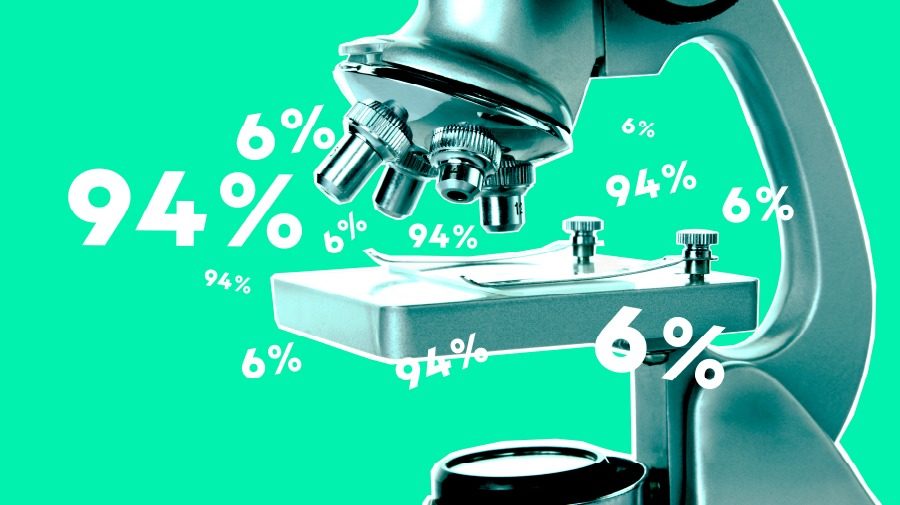Over the last weekend in August, more than 40,000 Twitter users shared what, at a glance, would have been a bombshell: “this week the CDC quietly updated the Covid number to admit that only 6% of all the 153,504 deaths recorded actually died from Covid. That’s 9,210 deaths.” For those skeptical of the dangers of the coronavirus, this was evidence they’d been right all along – and that their government had been lying to them to support a restrictive lockdown.
Unfortunately, the statistic was misleading. The CDC’s data only showed that most patients had a range of complications (also known as comorbidities), many directly caused by Covid-19, when they died. The statistic’s considerable spread is a prime example of how easy it is to spin data out of context, and the role the media can unwittingly play in amplifying misinformation.
On August 26, in a weekly update on provisional counts from death certificate data, the US Centers for Disease Control and Prevention said that for 6 per cent of deaths involving Covid-19, no other causes of death were mentioned. Even though this statistic had been visible on the CDC website for over a month, social media users and news organizations shared it as if it were a new finding, igniting a wave of claims that 94 per cent of the deaths purportedly from Covid-19 were really from other causes.
“It is absolutely common practice for there to be multiple causes and multiple diagnoses for a person’s death,” said Stephen Kissler, a postdoctoral fellow at the Harvard T.H. Chan School of Public Health who uses mathematical models to study the spread of infectious diseases.
This is particularly true of Covid-19, which kills in many ways. It causes pneumonia, aggravates hypertension and leads to respiratory failure, among others. That is why it’s unsurprising that these causes are listed in the CDC’s comorbidities data for 94 per cent of people, explained Christin Glorioso, a physician and research scientist at MIT. “Saying someone died of pneumonia and not Covid is a misconception, because Covid causes the pneumonia,” said Glorioso.
Kissler said that having a detailed record of all the health conditions at time of death is important for researchers who are analyzing the data. “Essentially, doctors are trying to be specific about not only the fact that a person had Covid, but what specifically about Covid led to the person’s death,” Kissler said. That detail means doctors are being thorough, not that Covid-19 is less deadly than previously thought, Kissler said.
How an old statistic took on new life
One of the first examples we found of a reporter citing these weekly figures was in a July 6 op-ed for Pennsylvania’s Pottstown Mercury. Writer Jerry Shenk cited similar figures from late June and concluded that people were dying “with the virus rather than from it”. On August 7, Twitter user @old_guys_rule2 posted the 6% statistic with the comment, “COVID-19: The largest PSYOPS campaign ever conducted on the American People.”
Later in August, the statistics began to travel more widely. On August 24, BlazeTV host Steve Deace made a post to his Facebook Page highlighting it, which was reshared more than 1,200 times. Five days later, the narrative made it to the top of Gab’s trending page, and the Facebook account DrElizabeth Hesse DC claimed that the CDC had “quietly updated the Covid number to admit that only 6 per cent of all the 153,504 deaths recorded actually died from Covid.”
On the same day, Twitter account @littllemel, a member of the QAnon community, tweeted a screenshot of that post, which was later retweeted by President Trump— and more than 40,000 other accounts. Facebook and Twitter removed the posts by DrElizabeth Hesse DC and @littllemel from their platforms.
Many users questioned the framing of the statistic, including in one tweet shared at least 2,900 times, but it caught the attention of several local newsrooms, which reported it without providing important context. Several local news stations ran headlines similar to one from Cleveland’s Fox 8: “New CDC report shows 94% of COVID-19 deaths in US had contributing conditions.”
The Atlanta Journal-Constitution published an article with a similar headline. It later removed the article, then published one debunking the mischaracterized statistic and acknowledging that it had “briefly” hosted an article mischaracterizing the data.
The cost of getting it wrong
Setting aside the false conclusions drawn from it, the CDC’s update hardly represented a newsworthy change concerning Covid-19’s relationship to comorbidities. “This [data] has been there. We have always said that an underlying condition was going to make you more susceptible to infection,” said Bruno Rodriguez, a virology Ph.D candidate at NYU Langone Health.
One particular danger of the media treating this statistic as if it were new, Kissler said, is promoting an idea that science is haphazard and rife with internal contradictions, when in fact a review of the CDC’s past data shows considerable consistency. A review of past versions of the CDC data shows that the agency actually reported the 6 per cent figure as far back as July 8. As early as May 12, the number was 7 per cent.
Kissler and Glorioso worry that the reporting also promotes an idea that Covid-19 isn’t deadly just because it kills people with health problems at higher rates. More than 45 per cent of Americans have a risk factor for Covid-19. “That’s a lot of us,” said Kissler, “and I think there’s something dangerous about this disregard for anyone but the absolutely fit and the totally healthy.”
Misinformation often benefits from messaging that is simple, easy to process, and plays into confirmation bias. This is all the more prevalent when it is based on a kernel of truth. In this way, ostensibly straightforward statistics like “only 6% of death certificates list Covid-19 as the only cause” and “94% of Covid-19 deaths involve underlying conditions,” when presented without the proper context, provide quick relief to those inclined to believe that the coronavirus is not deadly.
For more information, read our series on the psychology of misinformation.
“The thing that concerns me most about this sort of thing is that it erodes trust in the practical interventions we’re trying to take to keep people safe,” Kissler said. “We do ourselves a disservice in either lessening or overblowing the severity of the disease.”
Tips for reporting on Covid-19 statistics
- Check provenance and primary sources: you can use tools like the Wayback Machine to look at changes to websites like the CDC’s and investigate whether they are really new.
- For sources, reach out to medical professionals who are working in infectious disease epidemiology.
- See if those medical professionals have recent publications listed with their institution. This will help you gauge whether they are still active in the field and have the latest information.
- Exercise caution with data that seems to contradict previously available information about the pandemic.
- Beware of taking a single nugget of information and elevating it as a new finding.
Keenan Chen contributed research to this article.






